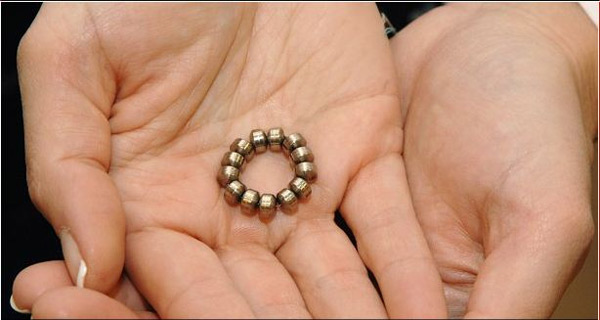
A bracelet-like device with magnetic beads can control the chronic digestive disorder gastroesophageal reflux disease, according to a study published online February 20 in the New England Journal of Medicine.
The device encircles the valve at the junction of the esophagus and stomach and helps it stay closed when a person is not eating or drinking. It eased symptoms in 92 of 100 patients with chronic acid reflux and allowed 87 percent of patients to stop using acid-suppressing drugs, third-year results from the five-year study showed. Ninety four percent of patients were satisfied with the treatment.
The advance is significant, says study co-author C. Daniel Smith, M.D., chair of the Surgery Department at Mayo Clinic in Florida and a specialist in treating reflux disease. Mayo Clinic is the only medical center in Florida and one of two in the Southeast to help study the device. Mayo Clinic in Arizona also offers treatment with the device.
“This is the first new, safe and effective treatment we have to treat reflux disease in 20 years,” Dr. Smith says. “The device is simple, elegant and functional, and it provides an opportunity to help a very large number of patients. The only treatment options in the past have been acid-suppressing agents or surgery. Acid-suppressing agents don’t directly address the underlying ineffective valve, leaving patients with persistent symptoms; surgery can lead to distressing side effects of bloating and inability to vomit in 20 percent of patients. These side effects occurred rarely with this new device.”
Roughly 1 in 3 people in the United States have the chronic condition, the American Gastroenterological Association estimates. It can lead to serious health problems.
Acid reflux stems from a deficient or incompetent sphincter valve located at the bottom of the esophagus and the top of the stomach. The sphincter, a ring of muscle, normally stays constricted when a person is not eating; that prevents acid and other digestive juice from leaving the stomach and entering the esophagus.
If the muscle is too weak or relaxes inappropriately, stomach acid can work its way into the lining of the esophagus causing pain and burning — commonly known as heartburn — and regurgitation. These episodes can happen at any time, and in people of all ages.
Excessive acid can damage the esophagus and lead to a precancerous condition known as Barrett’s esophagus and to esophageal cancer, which is rising rapidly in the U.S., Dr. Smith says. The epidemic of chronic acid reflux may explain the increase in cancer, he says. Dr. Smith has been offering the device to patients who qualify since March 2012, when the Food and Drug Administration approved it for use. He performs about 200 acid reflux-related surgeries a year.
Installation of the device is minimally invasive and takes one to two hours. After the procedure, patients stay overnight in the hospital.
Patients who may be helped by the device are those whose acid reflux is chronic with symptoms incompletely controlled by acid-suppressing drugs, Dr. Smith says.
Not all patients in the study fared well with the device. Serious adverse events occurred in six patients, and the device was removed in 4 patients without any significant long-term consequences. Dysphagia — difficulty swallowing — occurred in 68 percent of patients following installation of the device, but this side effect tapered off over time.
The study’s lead researcher is Robert A. Ganz, M.D., from Minnesota Gastroenterology in Plymouth, Minn.
The study was supported by Torax Medical, which developed the LINX Reflux Management System. Mayo Clinic physicians and scientists helped Torax Medical develop the device, and Mayo Clinic licensed related technology to the company in exchange for equity. Dr. Smith and Ken DeVault, M.D., chair of the Department of Internal Medicine at Mayo Clinic in Florida, who also participated in this study, are paid consultants to Torax Medical.